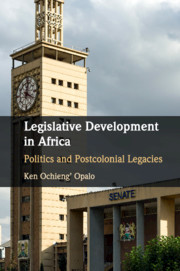Book contents
- Frontmatter
- Dedication
- Contents
- List of Figures
- List of Tables
- Preface
- Acknowledgements
- 1 Introduction
- 2 Legislative Development in Africa
- 3 Intra-Elite Politics and Credible Commitment
- 4 Colonial Origins of Parliaments in Kenya and Zambia
- 5 Elite Control and Legislative Development
- 6 Legislative Institutionalization in Time
- 7 Electoral Politics and Legislative Independence
- 8 Conclusion
- References
- Index
4 - Colonial Origins of Parliaments in Kenya and Zambia
Published online by Cambridge University Press: 17 June 2019
- Frontmatter
- Dedication
- Contents
- List of Figures
- List of Tables
- Preface
- Acknowledgements
- 1 Introduction
- 2 Legislative Development in Africa
- 3 Intra-Elite Politics and Credible Commitment
- 4 Colonial Origins of Parliaments in Kenya and Zambia
- 5 Elite Control and Legislative Development
- 6 Legislative Institutionalization in Time
- 7 Electoral Politics and Legislative Independence
- 8 Conclusion
- References
- Index
Summary
To explore the mechanisms behind the observed variation in legislative institutionalization and strength in Africa, this chapter provides a comparative historical study of legislative development in Kenya and Zambia. Both countries’ colonial Legislative Councils (LegCo) had a common Westminster origin and were dominated by European immigrants. However, contingencies of political development in the late colonial period put the two countries’ postcolonial legislatures on different trajectories of institutional development. First, colonial restriction of cross-ethnic political mobilization in Kenya produced district-cum-ethnic parties. Its independence party (KANU) was therefore little more than a confederacy of ethnic parties. In Zambia, urbanization in the Copperbelt created the social infrastructure to support mass politics under UNIP. KANU’s weakness enabled the Kenyan legislature to function as the main arena for intra-elite politics and the sharing of governance rents. In Zambia, UNIP’s organizational strength crowded out the legislature, relegating it to a mere constitutional conveyor belt of the party’s policies. Second, the two countries differed on the nature of interracial politics. Interracial discord in Zambia resulted in extra-institutional nationalist politics. Kenya’s nationalist political development took place largely within the LegCo. As a result, independence brought institutional legislative discontinuity in Zambia and continuity in Kenya.
- Type
- Chapter
- Information
- Legislative Development in AfricaPolitics and Postcolonial Legacies, pp. 99 - 131Publisher: Cambridge University PressPrint publication year: 2019

